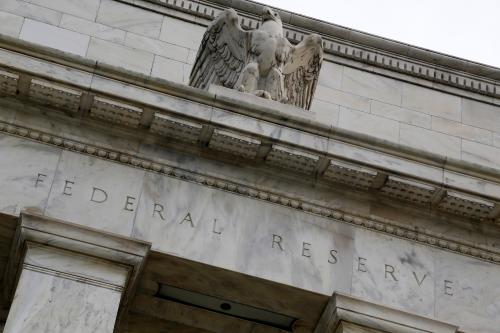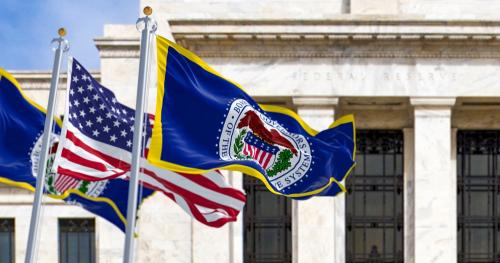The widely noted rise of bitcoin and other digital currencies could have profound impacts on financial systems and on the practices of the central banks. Will paper currency finally become obsolete? Will bitcoin and its siblings replace the dollar or the euro or the yen? Should central banks issue their own e-currencies? What opportunities do digital currencies present? What risks?
This post discusses answers offered by Agustin Carstens, General Manager of the Bank of International Settlements; Stefan Ingves, Governor of Sveriges Riksbank; Urjit Patel, Governor of the Reserve Bank of India; and Benoit Coeure, member of the Executive Board of the European Central Bank, to these and other questions. It draws primarily from a conference, “Digital currencies: Implications for central banks,” hosted by the Hutchins Center on Fiscal and Monetary Policy in April 2018 and a report, “Central Banking in a Digital Age: Stock-Taking and Preliminary Thoughts,” by our Brookings colleague, Eswar Prasad.
1. A lot of money is already electronic.
Although physical currency is still widely used in most countries (with the exception of Sweden, where the use of cash is shrinking rapidly), consumers around the world routinely conduct transactions without physical currency, using credit cards or mobile phones to pay. Further, much of the money that central banks (bank reserves) issue exists only in electronic form. So in some sense, the idea of digital currencies is not completely new.
Carstens: “When they introduced credit cards, we had to learn how to deal with credit cards. And nothing happened…we survived it. So I think that we will do the same [with digital currencies].”
Ingves: “[M]ost of the central bank money produced is wholesale central bank money, and all of that wholesale money is already electronic. So when we’re referring to cash, that’s…a tiny, tiny fraction of what’s going on in the system.”
2. Cryptocurrencies aren’t likely to replace government-backed currency soon.
Bitcoin and other cryptocurrencies are popular, but most people don’t trust them the way they trust the U.S. dollar, the euro, or the Japanese yen, all of which are backed by a central bank. Despite the erosion of confidence in government institutions, most people still prefer money backed by a central bank, and this is unlikely to change anytime soon.
Patel: “[O]n scalability, actually, some of the things that were promised have not happened. Bitcoin networks handle very few transactions per second, while, for example, an interbank Visa system handles a hundred times that. One reason…is because there is lopsided investment. That again underscores that you need a coordinator because you are getting parts of this whole system where a lot of money goes into the mining part [of bitcoin], and very little goes into everything else.”
Ingves: “What is very much underestimated when we talk about the technologies here is why people use central banks and like to use central bank payment systems…[I]f one bank pays another bank, and…it is not passed through the payment system of the central bank, the only thing that happens is that one bank ends up with a claim on another bank. And bankers don’t trust each other. And that’s why you have central banks transferring the money, because that’s the only safe way of transferring money.”
What is very much underestimated when we talk about the technologies here is why people use central banks and like to use central bank payment systems
Carstens: “[S]uddenly we have a new form of technology, and can we expect that that new technology will substitute for all these centuries of creating good practices that in a way generates the trust that society has on the currency that we know today? Will precisely another currency substitute for all of that? My answer is, with absolute certainty, no…[T]echnology cannot substitute for all what central banks do to make trustworthy currencies.”
3. Still, digital currencies could change the financial system in big ways.
Digital currencies and other innovations in payment systems could increase the speed of domestic and cross-border transactions, reduce transaction costs, and eventually broaden access to the financial system by poor and rural households.
Prasad: “Certainly, payment systems are going to become much more efficient. In China, in India, one can conduct very small micro-transactions with street vendors using payment systems that have been decentralized and that are intermediated, not through the traditional banks but through other platforms. And one can see this very easily catching on.”
Ingves: “New technologies make it easier for money to reach everybody, and that means that essentially what we’re talking about is sending money from one cell phone to another real time. And that’s a worthy vision for the future.”
New technologies make it easier for money to reach everybody…
Prasad: “[O]ne of the reasons why…we are seeing certain…political forces gaining power is because many people don’t feel connected to the economy. Connection to the financial system is a very important part of it. If you feel that the reforms in a country are going to benefit the elite who are connected and most of the others are left out, this is, I think, a very important part of that [frustration. Digital currencies] will give people more access to the financial system…So I think that is at some level a really transformative power in the new technologies.”
4. But these new technologies bring some big challenges too.
Digital currencies and related technologies are likely to reduce transactions costs and decrease the price of acquiring and sharing information, which sound good but can destabilize financial markets and intensify contagion from one market to another. They could undermine the business models of conventional banks and their role in the financial system, making it hard for central banks—which operate largely through the banking system—to maintain financial stability.
Prasad: “If one thinks about information flowing much more freely with the new technologies, that is certainly a compelling argument for why financial markets should work a lot better. But as we know from work that many academics have done…you might end up with certain information aggregators becoming very powerful in an economy where there is a lot of information but not very good processing ability, and that can actually lead to situations where, in fact, you have informational cascades, and herding and contingent behavior becomes worse, not because of limited information, but because there is too much information but not enough signal extracting and processing capability. So in terms of financial institutions and regulation, I think there are many challenges ahead.”
So what banks look like and whether they will still play a powerful role in the creation of money in this very broad sense is a critical issue.
Prasad: “[A]s many of the inefficiencies in the financial system are eroded away, the traditional competitive rents or anti-competitive rents that banks could collect are going to erode. So what banks look like and whether they will still play a powerful role in the creation of money in this very broad sense is a critical issue…[I]f traditional commercial banks play a much less important role in finance, if the central banks’ role in terms of settlement and facilitating payments across financial institutions starts eroding—that makes monetary policy implementation a lot more challenging.”
Prasad: “[W]hat happens as we start thinking about a scenario where payment systems become very decentralized? [C]entral banks do need to be worried about whether this decentralization and the fact that the payment mechanisms are not going to be anchored by any official foundation could create problems in bad times…there is a crisis of confidence when these decentralized payment systems start coming into question or start breaking down for a variety of reasons. That could affect not just monetary stability but economic activity as a whole.”
5. Should central banks issue their own digital currencies?
Very few central banks are seriously considering issuing their own digital currencies—that is, allowing the public to have electronic deposits at the central bank—but many central banks are talking about this option. So far, only a couple central banks have issued their own digital currencies, Ecuador and Tunisia among them. Sweden, where the use of cash is evaporating faster than almost any other sizeable economy, is contemplating whether to issue an e-krona.
Issuing its own digital currency would prevent a central bank from losing market share to bitcoin, and it could make it easier for a central bank to pursue negative interest rates (charge a fee to depositors rather than pay interest) during an economic downturn. But an official digital currency could reduce the role of traditional banks as intermediaries and lenders, and could pose big problems during a financial crisis, if depositors pull money out of traditional banks to deposit it at the (safer) central bank.
Ingves: “[T]he only remaining issue when it comes to this is to what extent it should be possible for the general public to hold an electronic claim on the central bank or not. Or whether we should instead have a system where only banks can have a claim on the central bank and all of this electronically.”
Patel: “[O]ne benefit of a central bank-issued digital currency is that the costs do come down. And that is something that everyone wants, including the government.”
[O]ne benefit of a central bank-issued digital currency is that the costs do come down. And that is something that everyone wants, including the government.
Coeure (in a May 14, 2018 speech at the International Center for Monetary and Banking Studies): “[A]lmost no euro area banks have passed these negative rates on to their household clients…if negative rates are not passed through, this [bank lending] channel will fail to develop to its full potential. An interest-bearing central bank digital currency may help overcome these constraints. This does not actually require cash to be abolished, but rather that it no longer acts as an effective competitor for large transactions. Under these conditions the central bank could gain greater control over the transmission of interest rates to households and businesses. In a deep recession, it could reduce interest rates by more than is currently possible and stabilize economic activity more quickly, reducing the need for other non-conventional measures. And in an upswing, the ability to pay positive interest rates on digital currency would put increased upward pressure on deposit rates provided by banks.”
Coeure: “In a systemic crisis…households and businesses could seek to hold their wealth in the riskless central bank liability rather than the riskier private sector one. While this shift could also happen now between deposits and cash, a digital currency would make it cheaper and faster, making ‘digital bank runs’ more frequent and more severe.”
Carstens: “Central bank digital currencies can facilitate wrongs against banks. They can attract resources to central banks [and] away from commercial banks. That opens a whole can of worms…the central banks are not created to intermediate financial resources.”
The Brookings Institution is committed to quality, independence, and impact.
We are supported by a diverse array of funders. In line with our values and policies, each Brookings publication represents the sole views of its author(s).





Commentary
Digital currencies: Five big implications for central banks
May 21, 2018